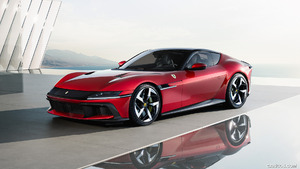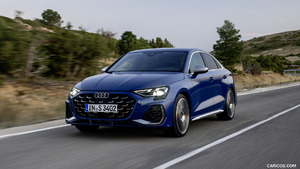2013 VW Polo BlueGT
Wolfsburg / Amsterdam, 02 July 2012 The new Polo BlueGT, with 103 kW / 140 PS and a combined fuel consumption of 4.5* l/100 (DSG version), brings together the two seemingly conflicting goals of ‘dynamics’ and ‘fuel efficiency’. The technical highlight of the sporty compact car is its progressive TSI engine with active cylinder management (ACT) – this cylinder deactivation feature alone, the world’s first in a four-cylinder engine, yields fuel savings of 0.4 l/100 km. In addition, the Polo BlueGT is an excellent example of how numerous aspects of the worlds of sportiness and fuel efficiency can be combined to create a new automobile – in this case by applying elements taken from the Polo GTI as well as the Polo BlueMotion.
Lighter and more efficient TSI. The 1,395 cc engine of the Polo BlueGT, which weighs in at just 114 kg, develops its specified 140 PS between 4,500 and 6,000 rpm. Equipped with the standard 6-speed manual gearbox, the Volkswagen has a combined fuel consumption of just 4.6* l/100 km/h Super Unleaded (95 octane); this is equivalent to CO2 emissions of 107* g/km. When the Polo BlueGT is ordered with the optional 7-speed dual clutch gearbox (DSG), fuel consumption is reduced to the previously mentioned 4.5* l/100 km (105* g/km CO2).
Power of a large car. Despite its sustainable fuel economy and emissions values, the compact Polo BlueGT is very agile: this Volkswagen, which has a top speed of 210 km/h, accelerates to 100 km/h in just 7.9 seconds. Also having a positive effect on dynamics is the high torque of the TSI. The torque curve is interesting in that it exhibits a plateau-like shape at its upper end: the maximum torque of 250 Nm is available at a low 1,500 rpm and remains constant at this level right up to 3,500 rpm. This uncommon coexistence of efficiency and dynamic performance is enabled by the systematic interplay of ACT, downsizing (reduced engine displacement plus direct injection and charging) and BlueMotion Technologies (Stop/Start system, battery regeneration).
Engine technology – the 1.4 TSI with ACT in detail
New engine family. The 1.4 TSI of the Polo BlueGT is the top engine of the entirely new EA211 series of petrol engines that has been developed. The engine range consists of 1.0, 1.2 and 1.4 litre engines. The efficient 1.0-litre three-cylinder engines (MPI engines without charging between 44 kW / 60 PS and 55 kW / 75 PS) are used to drive such cars as the new up!. The 1.2- and 1.4-litre four-cylinder engines were each designed as charged direct fuel injection engines (TSI). They produce 63 kW / 85 PS and 77 kW / 105 PS (both 1.2 litre) as well as 90 kW / 122 PS and 103 kW / 140 PS (both 1.4 litre). One feature common to all engines is their cylinder spacing of 82 mm. Technically, the engines were also designed for use in the future Modular Transverse Matrix (MQB) with identical engine mounting positions.
Aluminium block reduces weight. Thanks to an ultra-rigid aluminium die-cast crankcase, the new petrol engines are especially light with a maximum weight of 114 kg. A point of reference: the 1.4 TSI of the new Polo BlueGT is a respectable 22 kg lighter than its grey cast iron counterpart of the previous engine series. The meticulously practised lightweight construction for which Volkswagen is renowned extends to the smallest of details: for example, engine developers reduced the crankshaft main bearing diameter of the 1.4 TSI from 54 to 48 mm; the crankshaft itself was lightened by 20 per cent, while the weight of the connecting rods was even reduced by 25 per cent. The rod bearing pins are hollow bored, and the aluminium pistons (now with flat piston crowns) have also been weight-optimised.
Exhaust manifold in the cylinder head. Particular importance was also paid to the whole issue of thermal management. To use optimally the thermal energy of the exhaust in the hot running phase, and on the other hand to cool it more effectively at high loads, the exhaust manifold of the new EA211 engines was, for example, integrated in the cylinder head and was provided with its own cooling jacket.
Small turbocharger, big effects. By means of the innovative construction of the exhaust manifold, Volkswagen was also able to use just a very narrow single-scroll compressor in turbocharger selection. Once again, this reduced the engine’s weight. In the EA211, the intercooler was integrated in the induction pipe which is made of injection-moulded plastic. The advantage: significantly accelerated pressure build-up. And this has resulted in very responsive downsized engines.
Toothed belt in the valve drive. In the new generation of engines, Volkswagen was also able to make further significant reductions in internal friction. Take the example of the overhead camshafts (DOHC): the drive here is not by chain, rather by a single-stage, low-friction toothed belt drive with a 20 mm wide belt and load-reducing profiled belt wheels. Thanks to its high-end material specification, this toothed belt’s service life reliably spans the life of the entire vehicle! Actuation of the valve drive via roller cam followers and an anti-friction bearing for the high loads of the first camshaft bearing also lead to reduced friction resistances. To ensure that the engine takes up as little mounting space as possible, ancillary components such as the water pump, air conditioning compressor and alternator are screwed directly to the engine and the oil sump without additional brackets, and they are driven by a single-track toothed belt with a permanent tension roller.
Variable camshaft for more torque. To reduce emissions and fuel consumption further, and to improve torque in the lower rev range, the intake camshaft on all EA211 engines was designed to be adjustable over a crankshaft angle range of 50 degrees– on the 140 PS 1.4 TSI of the new Polo BlueGT an exhaust camshaft adjuster is added. It permits the desired spread of control times, enabling even more spontaneous response from low revs; at the same time, torque is improved at high revs.
200 bar injection pressure. The maximum injection pressure of the new TSI versions (direct fuel injection) is 200 bar – for a petrol engine a very high level. State-of-the-art five-hole injection nozzles deliver up to three individual injections to each of the cylinders via a stainless steel distributor bar with extreme precision. In designing the combustion chamber, Volkswagen also paid particular attention to achieving minimal wetting of the combustion chamber walls with fuel and to optimised flame propagation.
ACT facts. The outstanding technical aspect of the BlueGT engine is its active cylinder management (ACT). Volkswagen is the first carmaker to implement this fuel saving cylinder deactivation technology on four-cylinder engines, as it was previously the preserve of large eight or 12 cylinder engines. Shutting down the second and third cylinders during low and medium load states reduces fuel consumption in the EU driving cycle by about 0.4 l/100 km. For urban driving it saves as much as 1.0 l/100 km. Even while driving at 70 km/h in fifth gear, fuel consumption of the Polo BlueGT is reduced by 0.7 l/100 km.
ACT mode of operation. ACT is active over an engine speed range between 1,400 and 4,000 rpm and torque outputs between 25 and approx. 100 Nm – a broad characteristic map that covers nearly 70 per cent of all driving states in the EU driving cycle! If the driver presses the accelerator pedal hard, both cylinders begin to work again without a noticeable transition. The high efficiency of the system does not have any negative effects on smooth running: even with two cylinders the excellently balanced 1.4 TSI of the Polo BlueGT runs very quietly and with low vibration. All mechanical switchover processes take place within one-half of a camshaft rotation; depending on engine speed this takes between just 13 and 36 milliseconds. Accompanying interventions in ignition and throttle valve processes smooth the transitions. What’s more, thanks to an accelerator pedal sensor and intelligent monitoring software, the system can also detect irregular driving profiles – such as during a drive through a roundabout or in sporty shifting on a highway. In such cases, cylinder shut-off is deactivated. The driver is aware of whether two or four cylinders are active by a related indicator in the multifunction display between the speedometer and tachometer.
ACT components. Altogether, the components of active cylinder management weigh just three kilogrammes. Their actuators, the camshafts and their bearing frames are integrated in the cylinder head; two low-friction bearings reduce friction of the shafts. Important to know: only with the TSI concept – petrol direct injection plus turbocharging – is cylinder deactivation even conceivable in its form today.
Standard features
BlueGT exterior. The new Volkswagen looks special – both outside and inside. From the outside, it is the new 17-inch alloy wheels with spoke styling, GT signatures at the front and rear (and additional ‘BLUEMOTION’ at the rear) and a new twin tailpipe that are the identifying characteristics of the Polo BlueGT. In addition, numerous standard features were adapted from the Polo GTI or the Polo BlueMotion. GTI features include the rear spoiler, rear bumper with diffuser, front bumper and fog lights including daytime running lights. BlueMotion elements include the side sills and the front rain channels (outside on the windscreen). The Polo BlueGT is also upgraded thanks to a black painted radiator grille, R-line ventilation screen in the bumper and black door mirrors. Special underbody trim has a positive effect on the car’s aerodynamics. The 15 mm lower sport chassis (with MacPherson-type front suspension and semi-independent rear suspension) not only improves aerodynamics, but also the car’s dynamic performance. Like all Polo models, the BlueGT also has green tinted heat-insulating glass.
BlueGT interior. Interior features were upgraded by extending the functionality of the multifunction display (ACT and tyre pressure indicators), the GTI instruments, a cruise control system, black roofliner and black pillar trim in GTI style, vanity mirrors in the sun visors and interior lights tuned to them, a leather-trimmed sport steering wheel with ‘BlueGT’ emblem, sport seats in front with newly designed trim (fabric type and colour) as well as various chrome surrounds. Other standard features: electrohydraulic steering, electric front windows, remote central locking, boot illumination and lashing points, warning buzzer when lights are left on and a height adjustable driver’s seat.
BlueGT safety. Naturally, the Polo BlueGT also offers comprehensive safety features. In the area of active safety, these include ABS, ESP with hill hold assist and the electronic XDS differential lock. For the best possible protection, passive safety is provided by a network of front airbags and combined head/thorax airbags (front passenger seat airbag can be deactivated), five head restraints, five three-point seatbelts (height-adjustable at front seats), belt tensioners and belt force limiters in front, automatic hazard light activation with full braking, daytime running lights and Isofix fitting points for suitable child seats (outer seats on rear bench). The front head restraints were also designed to reduce whiplash injuries.












